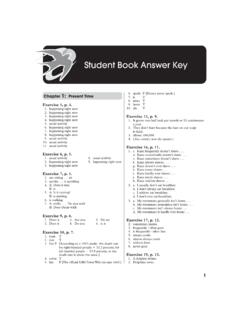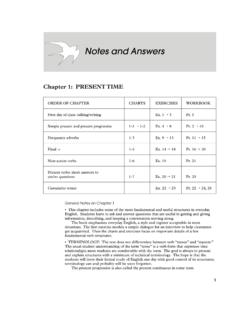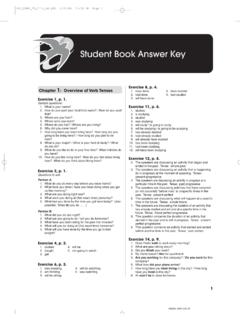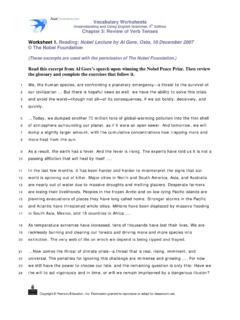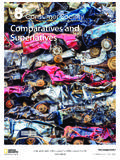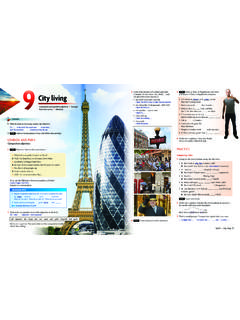Transcription of 09 ph/prs AZAR 39601
1 09_ph/prs_AZAR_39601 11/6/02 9:21 AM Page 114. Chapter 9: COMPARISONS. ORDER OF CHAPTER CHARTS EXERCISES WORKBOOK. Preview Ex. 1. Comparisons with as .. as 9-1 Ex. 2 6 Pr. 1 5. comparative and superlative 9-2 9-3 Ex. 7 13 Pr. 6 11. Comparatives 9-4 9-6 Ex. 14 19 Pr. 12 15. Unclear comparisons 9-7 Ex. 20 Pr. 16. Using more with nouns 9-8 Ex. 21 Pr. 17. Repeating a comparative 9-9 Ex. 22 Pr. 18. Double comparatives 9-10 Ex. 23 Pr. 19 20. superlatives 9-11 Ex. 24 28 Pr. 21 22. Pr. 24 25. Summary review Ex. 29 31 Pr. 23, 26 27. The same, similar, different, like, alike 9-12 Ex.
2 32 35 Pr. 28 31. Cumulative review Ex. 36 37 Pr. 32. General Notes on Chapter 9. Students will learn a variety of structures to express comparison, contrast, and related ideas. The assumption is that students have already been introduced to simple phrases of comparison. This chapter both reviews and expands on those forms, emphasizing idiomatic usage. TERMINOLOGY: The terms comparative and superlative are used traditionally here and associated with -er/more and -est/most, respectively. 114. 09_ph/prs_AZAR_39601 11/6/02 9:21 AM Page 115. exercise 1, p.
3 247. Preview of comparisons. (Chapter 9). This exercise can be used as an oral introduction to the functions of comparisons, especially those using as .. as, comparatives, and superlatives . Elicit sentences from the class. Preview the grammar in this chapter. Note problems your students are having. Following are some typical errors in the use of comparison structures: INCORRECT: Line B is the longer of all. INCORRECT: Line B is the longest from all. INCORRECT: Line C is shortest than line B. INCORRECT: Line C is shorter that line B. INCORRECT: Line C is more short than line B.
4 INCORRECT: Line C is more shorter than line B. INCORRECT: Line C is shorter as line B. INCORRECT: Line D is as short than line E. INCORRECT: Line D is short as line E. (omission of first as). INCORRECT: Line E is very shorter than line B. SAMPLE RESPONSES: 2. Rick looks as happy as Jim. Rick and Jim look happier than Mike and David. David looks sadder than the others. David looks the saddest of all. Mike is happier than David but not as happy as Rick or Jim. Jim is the happiest of the four boys. OR Rick looks just about as happy as Jim. Etc. 3. Canada is the largest of the four countries.
5 Brazil is almost as large as Canada. Brazil is larger than Egypt and Spain put together. Spain is the smallest of the four countries. Spain is much smaller than Brazil or Canada. Etc. 4. The second question is the hardest of all. The first and fourth questions are the easiest. The fourth question is just as easy as the first question. The third question is harder than the first or fourth but easier than the second. Etc. 5. C is the best handwriting. A is the worst handwriting. C is better than either A or B. A is worse than B. B is worse than C. A isn't nearly as good as C.
6 Etc. Notes and Answers 115. 09_ph/prs_AZAR_39601 11/6/02 9:21 AM Page 116. 9-1: MAKING COMPARISONS WITH AS .. AS. Discuss the examples. Then for reinforcement, ask the students to cover the chart and tell you about the four people in the pictures. Or use the ages of three students in your class and a child (possibly yours or a student's) to elicit the same structures as in the examples. The use of the modifiers quite, nearly, almost, and just may be difficult for some learners and require special teaching attention. Return to exercise 1 and elicit comparisons that use these modifiers, or make up additional situations for oral work by using objects/people in the classroom or pictures drawn on the board.
7 A topic that easily lends itself to comparison is people's heights ( , Ali isn't quite as tall as Roberto, etc.). If you use this situation, make sure you know your students well enough to be assured that the shortest person in the group to be compared is not sensitive about being short. Other things that could be compared are hair length, book size, or size of circles drawn on the board, to name a few. Practices in the Workbook also emphasize use of modifiers with as .. as. In the negative, so can be used instead of the first as with no change in meaning: not so.
8 As has the same meaning and use as not as .. as. For example, Line A is not so long as line B Line A is not as long as line B. The use of so in negative comparisons is no longer as common in everyday English as it once was. Many people use not as .. as. exercise 2, p. 249. Comparisons with AS .. AS. (Chart 9-1). ANSWERS: 2. not nearly as 5. not nearly as 3. just as 6. just as 4. almost as / not quite as 7. almost as / not quite as exercise 3, p. 249. Comparisons with AS .. AS. (Chart 9-1). EXPECTED COMPLETIONS: 3. A lake isn't (nearly) as .. an ocean 4.
9 Honey is just as .. sugar 5. Money isn't (nearly) as .. good health 6. Children usually aren't as .. adults 7. A solar system isn't (nearly) as .. a galaxy 8. People aren't (nearly) as .. monkeys 9. reading a novel is just as / isn't nearly as .. listening to music exercise 4, p. 250. Comparisons with AS .. AS. (Chart 9-1). This exercise includes clause completions for as .. as comparisons. The use of subjects and verbs in comparison clauses is not discussed in Chart 9-1, but will be addressed in Chart 9-4 in relation to comparatives. Some items in this exercise ask students to come up with expressions with as.
10 As that they might have encountered before. For example, as fast as I can is a common expression that the students may already be familiar with. POSSIBLE COMPLETIONS: 3. as fast as I can 4. as sour as a lemon 5. as wide as a river 6. as difficult as I (had) expected 7. as often/much as you can 8. as (young) as you feel 9. as easy as you might think / as easy as it looks 10. as long to drive to the airport as it takes to fly to Chicago 116 CHAPTER 9, Comparisons 09_ph/prs_AZAR_39601 11/6/02 9:21 AM Page 117. exercise 5, p. 251. Comparisons with AS .. AS.
